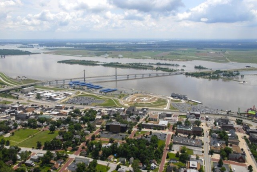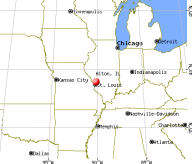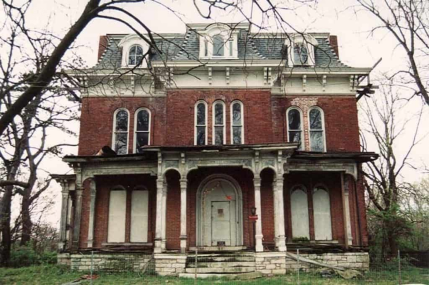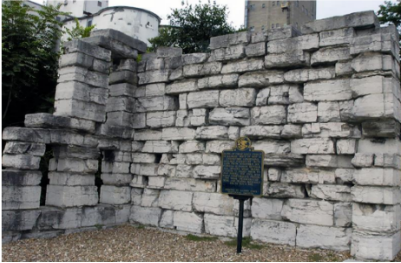Alton, Illinois 作者: 来源: 发布时间:2021-11-03
I.Population and Area
₋Area
Land: 16.96 sq mi (43.93 km2)
₋Population
Total: 27,865
Density: 1,671.32/sq mi (645.32/km2)

II.Natural Geography

Downtown & City Top View
₋Alton is a city on the Mississippi River in Madison County, Illinois, United States, about 18 miles (29 km) north of St. Louis, Missouri. The population was 27,865 at the 2010 census. It is a part of the Metro-East region of the Greater St. Louis metropolitan area. It is famous for its

₋limestone bluffs along the river north of the city, for its role preceding and during the American Civil War, and as the home town of jazz musician Miles Davis and Robert Wadlow, the tallest known person in history. It was the site of the last Abraham Lincoln and Stephen Douglas debate in October 1858. The former state penitentiary in Alton was used during the Civil War to hold up to 12,000 Confederate prisoners of war.
III.ECONOMY
₋The average salary in Alton, IL is $15.67. Trends in wages increased by 0.5 percent in Q1 2020. The cost of living in Alton, IL is 100 percent higher than the national average. The most popular occupations in Alton, IL are Registered Nurse (RN), Certified Nurse Assistant (CNA), and Registered Medical Assistant (RMA) which pay between $9.85 and $30.30 per year. The most popular employers in Alton, IL are Alton Memorial Hospital, BJC HealthCare, and The Home Depot Inc..
₋Website: https://www.payscale.com/research/US/Location=Alton-IL/Salary
IV.Industrial Characteristics
₋In the late 19th and 20th centuries, Alton became a town of heavy industry and manufacturing. Laclede Steel established major steel manufacturing operations in the town. Local industry also includes Cope Plastics and Hanley Industries. Alton was home to once-thriving, now defunct, industries such as the Owens-Illinois Glass Bottle Works and Alton Box Board Company (a maker of all types of cardboard boxes for all types of uses).
₋Restructuring in the industry in the mid-20th century led Alton to create a new future. It has facilities for corporate and vacation retreats and it has transitioned into a popular tourist destination. Alton's location and historical heritage make it a popular destination for antique shopping, touring historic areas, and gambling aboard the Argosy Casino. Other Greater Alton attractions include Alton Marina; nine golf courses, including Spencer T. Olin, the only Arnold Palmer-designed and -managed course in Illinois or the St. Louis Metropolitan area; fine dining and night life; and a large selection of bed-and-breakfasts and guest houses. These include the Beall Mansion An Elegant Bed & Breakfast Inn, voted "Best Illinois Bed and Breakfast" in the Illinois Magazine Readers Poll. Billing itself as "the wedding capital of the Midwest", Alton has become a popular venue for weddings, receptions, and honeymoons.
₋Some visitors come to explore the natural environment of the area.[citation needed] A designated bikeway extends for miles north of town along the Mississippi River and below the limestone bluffs; its relatively flat grade and passage through tree-shaded areas makes it an easy ride for families. During the migration seasons, Alton is a destination for birdwatchers along the Mississippi Flyway; winter visitors come to see the bald eagles that roost on the Illinois limestone bluffs and feed on fish in the river. It is the area of the Meeting of the Great Rivers National Scenic Byway. A few miles to the north is Père Marquette State Park, with a WPA-era lodge and attractions including trails for hikers and riders, and horses for hire.
₋On January 28, 2010, Illinois was selected for a $1.2 billion federal award to bring high-speed passenger rail service to Illinois by 2015–2017. Alton has been selected as a station stop on a line running from St. Louis to Chicago, and opened on September 13, 2017.
₋Alton also won the Small Business Revolution: Main Street contest and got a $100,000 boost to its community.
V.Attractions
1.McPike Mansion

₋McPike Mansion, or Mount Lookout, is a mansion in Alton, which is part of the Metro-East region of the Greater St. Louis metropolitan area in the U.S. state of Illinois. Built in 1869 by Henry Guest McPike (1825–1910), it is situated on Alby Street on a site of 15 acres (61,000 m2), one of the highest points in Alton, which was called Mount Lookout.
₋Construction began in 1869 by the architect Lucas Pfeiffenberger. In that year, McPike's Rulander was considered one of the finest in quality at an exhibition of the Mississippi Valley Grape Growers' Association, while his Diana was best on exhibition. McPike served as mayor of Alton and was a notable local businessman, involved in real estate and box making. He also served as the Librarian of the Alton-Southern Illinois Horticultural Society in the late 1880s. He died in 1910.
₋In 1925, the mansion was purchased by Paul A. Laichinger, who rented rooms out to others and lived there until his death in 1945. While the house was abandoned for years thereafter, there was some interest in demolishing it and converting the land into a shopping center, though this fell through due to zoning issues. In the meantime, the house was ransacked for what was left behind, including its furnishings, wooden banisters and even the toilets, becoming a victim of vandalism and negligence.
₋The structure was listed on the National Register of Historic Places on June 17, 1980 but was left derelict for many years, before being purchased by Sharyn and George Luedke in an auction in 1994. They had intended to convert it into a hotel, but contrary to earlier assurances at auction, they were unable to secure restoration grant money from any federal, state, or local agencies. Despite this, the Luedkes have overseen a restoration process, funded through donations and tours. In 2017, the Alton Historical Commission presented them with an award in preservation for work done on the front porch and conservatory.
₋Address: 2018 Alby St, Alton, IL 62002, United States
₋Phone: +1 618-830-2179
₋Website: http://www.mcpikemansion.com/
2.Confederate Prison Site

₋In just three years, more than 11,700 Confederate prisoners passed through the gates of the Alton Prison and were held captive with its walls. The Alton Prison, opened in 1833 and closed in 1860, was the first Illinois State Penitentiary. In December of 1861, after inspecting the facilities, Major General Henry Halleck, Commander of the Department of the Missouri, prepared to have the prison re-opened as a the Alton Federal Military Prison. On Feb. 9, 1862, the first prisoners arrived at the prison. Inmates of the prison included Confederate soldiers, citizens imprisoned for treason acts, and bushwackers or guerillas imprisoned for acts against the government. Much of the time, the prison was overcrowded, prisoners were malnourished and had inadequate clothing. Under these dilapidated conditions, prisoners were exposed to influenza, dysentery and small pox. The small pox epidemic grew in numbers, and the official military death toll listed 1,354 deceased. A monument dedicated to those who perished can be found at their burial site in the Confederate Cemetery. After the war, the prison was privately purchased and building blocks were removed. The remaining small portion of the wall was restored in 1973 and may be visited today.
₋Address:
žWilliams St. at Broadway
žAlton IL 62002
₋Phone: +1 618-465-6676
₋Toll Free: +1 800-258-6645
₋Email: info@visitalton.com
₋Website: http://www.visitalton.com/feature-stories/detail/80/walk-with-lincoln
3.National Great Rivers Museum
₋The 12,000-square foot National Great Rivers Museum is located on the Meeting of the Great Rivers National Scenic Byway at the Melvin Price Locks and Dam #26.
₋Adjacent to the regional bike trails and situated on the banks of the Mississippi River, this museum is dedicated to telling the story of the people, nature, and wildlife that have shaped the mighty river throughout history. The museum is packed with 20 highly interactive and computer animated exhibits that illustrate the impact of the Mississippi River on people and the region.
₋Public Lock tours are availalbe Wednesday - Saturday at 10 a.m., 1 p.m., and 3 p.m. (tours begin promptly) The tours are free and last approximately 45 minutes to one hour; requires ½ mile walk and heights of approximately 80 feet. Public tours are limited to 25 participants. Group Tours Groups of 10 or more need to call the Alton Visitor Center at 1-800-258-6645 to schedule a tour. Group tours available Wednesday - Saturday at 9 a.m., 11 a.m., and 2 p.m. Allow at least 1 1/2 hours to visit both the museum and locks and dam. School/children groups require at least one adult chaperone per 10 students. Student activity sheets are available to assist in the museum experience.
₋History of the Museum: Constructed by the U.S. Army Corps of Engineers as a component of the Melvin Price Locks and Dam, the museum structure was completed in 1998 at a price of $6 million. The completed museum features an exhibit gallery that is approximately 7,000 square feet, a multi-purpose classroom with Distance Learning capabilities, a theater with seating for 100, with state-of-the-art audio-visual components, and a gift shop.Exhibits and DisplaysThroughout history, people have relied on the Mississippi River. It has played an important role historically, culturally and ecologically for both nature and humans.
₋The journey down the Mississippi River begins with exhibit space dedicated to establishing the importance of the river, as well as telling the story of the forces that change the river’s course over time. See how ongoing cycling forces shape life on the river at interactive computer displays, discover the habitats along the river, find out more about the ancient beginning of the river as told by the majestic bluffs, and experience where the great rivers meet.Our RiverVisitors begin their journey down the Mississippi River with an introductory exhibit establishing the importance of the Mississippi River. Throughout history, people have valued and relied upon the Mississippi River. Within this exhibit space, visitors can explore additional displays that capture the life and natural forces of the river. The Bluffs: Towering above the Mississippi River, the majestic limestone bluffs support many life forms that enrich the river today and continue to tell the unique story of the river’s ancient beginnings. The Confluence: It is here that the great rivers meet. Discover the points where the Mississippi converges with the Missouri River and Illinois River.
₋Locks and Dam System: The Melvin Price Locks and Dam is considered by many to be a national marvel of engineering right here on the Mississippi River. While examining the history and development of the locks and dam system, visitors can explore a number of displays showing how the locks and dam are used along the river. A Stairway for Boats: The lock and dam system is like a stairway for boats, making it possible for large boats to travel the Upper Mississippi River. Visitors can try for themselves to move the water in the locks in order to balance the water levels. Life Size Barge: River navigation is important to the U.S. economy, and we need large barges to move our goods, such as corn, soybeans and coal. When stepping under the frame of a barge, visitors can experience how vast a barge is in size, as well as how cargo is stored inside. Steer the Barge: Navigating the Mississippi, with all its natural and engineered challenges, takes a lot of skill and experience – and it can be really fun! Kids of all ages can take a stab at pushing a barge through the locks and dam with a simulator.
₋People and the River: People do not always realize how much the water and the environment play an integral role in their daily lives. The following exhibits allow visitors to take a closer look at their home environments and how they can take care of preserving the river environment. How much water do you use?: Whether we’re taking a bath or grabbing a drink of water, it is important to be aware of our personal water consumption. This interactive display allows visitors to fill the tank with the water they consume each day, and then they can learn ways to use their water resources more wisely. Working with the River: Lots of people care about the Mississippi and do all sorts of work in several agencies to take care of the river environment. This exhibit pays tribute to all those who help maintain the Mississippi River.
VI.History
₋Although Alton once was growing faster than the nearby city of St. Louis, a coalition of St. Louis businessmen planned to build a competing town to stop Alton's expansion and bring business to St. Louis. The resulting town was Grafton, Illinois.
₋Many blocks of housing in Alton were built in the Victorian Queen Anne style. They represent a prosperous period in the river city's history. At the top of the hill in the commercial area, several stone churches and a fine city hall also represent the city's wealth during its good times based on river traffic, manufacturing and shipping. It was a commercial center for a large agricultural area. Numerous residences on hills have sweeping views of the Mississippi River.
₋Early history
₋The Alton area was home to Native Americans for thousands of years before the 19th-century founding by European Americans of the modern city. Historic accounts indicate occupation of this area by the Illiniwek or Illinois Confederacy at the time of European contact. Earlier native settlement is demonstrated by archaeological artifacts and the famous prehistoric Piasa bird painted on a cliff face nearby. The image was first written about in 1673 by French missionary priest Father Jacques Marquette.
₋19th century
₋Alton was developed as a river town in January 1818 by Rufus Easton, who named it after his son. Easton ran a passenger ferry service across the Mississippi River to the Missouri shore. Alton is located amid the confluence of three significant navigable rivers: the Illinois, the Mississippi, and the Missouri. Alton grew into a river trading town with an industrial character. The city rises steeply from the waterfront, where massive concrete grain silos and railroad tracks were constructed in the 19th and 20th centuries to aid in shipping the area's grains and produce. Brick commercial buildings are located throughout downtown. Once the site of several brick factories, Alton has an unusually high number of streets still paved in brick. The lower levels of Alton are subject to floods, many of which have inundated the historic downtown area. The flood levels of different dates are marked on the large grain silos, part of the Ardent Mills, near the Argosy Casino at the waterfront. The flood of 1993 is considered the worst in the last 100 years.
₋It became an important town for abolitionists, as Illinois was a free state across from the slave state of Missouri. Pro-slavery activists also lived there and slave catchers often raided the city. Escaped slaves would cross the Mississippi to seek shelter in Alton, and proceed to safer places through stations of the Underground Railroad. During the years before the American Civil War, several homes were equipped with tunnels and hiding places for stations on the Underground Railroad to aid slaves escaping to the North. On November 7, 1837, the abolitionist printer Reverend Elijah P. Lovejoy was murdered by a pro-slavery mob while he tried to protect his Alton-based press from being destroyed for the third time. He had moved from St. Louis because of opposition there. He had printed many abolitionist tracts and distributed them throughout the area. When one of the mob made a move to set the old warehouse on fire, Lovejoy, armed with only a pistol, went outside to try to stop him. The pro-slavery man shot him dead (with a shotgun, five rounds through the midsection); the mob stormed the warehouse and threw Lovejoy's printing press into the Mississippi. Lovejoy thus became the first martyr of the abolition movement.
₋Alton became the seat of a diocese of the Catholic Church in 1857. Its first bishop was French-born Henry Damian Juncker. The new diocese had 58 churches, 18 priests and 50,000 Catholics. When he died, 11 years later, the churches were 125, the priests more than 100, and the Catholics 80,000. He was succeeded by Peter Joseph Baltes from Germany (1869–1886) and James Ryan (1888–1923). In 1923 the bishop's seat was moved to Springfield, Illinois. The Diocese of Alton, no longer a residential bishopric, is today listed by the Catholic Church as a titular see. Titular bishops appointed to the see have been John Clayton Nienstedt and Josu Iriondo.
₋On October 15, 1858, Alton was the site of the seventh Lincoln-Douglas debate. A memorial at the site in downtown Alton features oversized statues of Lincoln and Douglas, as they would have appeared during the debate. Congressional representatives came to Alton when they drafted the Thirteenth Amendment of the Constitution, to permanently end slavery throughout the Union. Alton resident and US Senator Lyman Trumbull, chairman of the Senate Judiciary Committee, co-wrote the Thirteenth Amendment. His Alton home, the Lyman Trumbull House, is a National Historic Monument.
₋Just two weeks into the American Civil War, Alton played an important part in the infamous Camp Jackson Affair, which in large part led to the eviction of Missouri Governor Claiborne Fox Jackson from office. The State of Missouri's nominal neutrality was tested in a conflict over the St. Louis Arsenal. The Federal Government reinforced the Arsenal's tiny garrison with several detachments, most notably a force from the 2nd Infantry under Captain Nathaniel Lyon. Concerned by widespread reports that Governor Jackson intended to use the Missouri Volunteer Militia to attack the Arsenal (and capture its 39,000 small arms), Secretary of War Simon Cameron ordered Lyon (by that time in acting command) to evacuate the majority of the munitions to Illinois. 21,000 guns were secretly evacuated to Alton, IL on the evening of April 29, 1861.
₋The first penitentiary in Illinois was built in Alton. While only a corner of it remains within a few blocks of the river, it once extended nearly to "Church Hill". During the American Civil War, Union forces used it to hold prisoners of war, and some 12,000 Confederates were held there. During the smallpox epidemic of 1863–1864, an estimated 1500-2200 men died. A Confederate mass grave on the north side of Alton holds many of the dead from the epidemic and a memorial marks the site. Often when Confederate prisoners escaped, they tried to cross the Mississippi River back to the slave state of Missouri.
₋20th century
₋Robert Pershing Wadlow, listed in the Guinness Book of Records as the world's tallest documented man at 8 feet 11.1 inches tall, 2.72 m, is buried in Oakwood Cemetery in the area known as Upper Alton. The earth over his grave was raised so visitors can compare its length to other graves. A memorial to him, including a life-sized statue and a replica of his chair, stands on College Avenue, across from the Southern Illinois University Dental School.
₋The Sisters of St Francis of the Martyr St George have their American province motherhouse in Alton.
₋In 1937 two commercial fishermen from Alton caught a bull shark in the Mississippi River. Late that summer they had realized something was troubling their wood and mesh traps. Concluding that it was a fish, they built a strong wire trap and baited it with chicken guts. The next morning, they caught the 5-foot 84-pound shark, which they displayed in the Calhoun Fish Market, where it attracted crowds for days.
₋World War II saw a group of seven brothers joined the military and variously became decorated veterans. Among these were Millard Glen Gray, who was decorated by Douglas MacArthur, and Neil Gray, who received the Silver Star.[6]
₋In 1954, the city of Alton was named as one of the three finalists for the location of the new United States Air Force Academy. Alton lost to the winning site of Colorado Springs, Colorado.
₋Because of Alton's location at the Mississippi River, the Great Flood of 1993 with its high water level caused severe damage to the city. Alton's water supply was cut off due to flooding, and townspeople had to be supplied with bottled water for more than three weeks. Many local businesses, including Anheuser-Busch of St. Louis, donated funds to help the people of Alton.
₋The original bridge connecting Alton with West Alton, Missouri, was a two-lane (one in each direction) bridge that had become a hazard for motorists and a hindrance for emergency vehicles. The northernmost bridge in the St. Louis metropolitan area, it was torn down in the 1990s. The current Clark Bridge, with two lanes of divided traffic in each direction, plus two bike lanes, opened in 1994. Work had proceeded during the Great Flood of 1993. The award-winning cable-stayed design was done by Hanson Engineers of Springfield, Illinois. Pieces of cables identical to those of the bridge were handed out in educational settings all over the city to allow the city's children to "take home a piece of the bridge". The complex work of construction of the bridge, in which engineers had to deal with the strong river current, barge traffic and the 1993 flood, was featured in the documentary Super Bridge on Nova.
VII.Other Information
₋Arts
₋Alton is home to the Jacoby Arts Center (JAC) (formerly the Madison County Arts Council), a not-for-profit organization that supports local arts and art education and is partially funded by the Illinois Arts Council. It is located on Broadway between Henry and Ridge Streets in the building that housed the Jacoby Furniture Store for nearly 100 years. The JAC is a regional arts center, serving 17 counties throughout south central Illinois, providing a public art gallery, art classes in a variety of media for adults and children, strong performing arts programming including a monthly live music performance, and an outlet to the literary arts, through such programs as the "Poetry Out Loud" high school-level competition and support of the Alton Writers Guild.
₋Alton is also home to the Alton Symphony Orchestra (ASO). In 2011, the ASO is in its 66th season, and is considered one of the premier community orchestras in the Midwest. Musicians range from young adults in their teens to senior citizens. It holds four regular season concerts, a stylish pops concert, and a children's concert; the symphony offers performances to entertain and educate diverse sectors of the community.
₋Theater
₋Founded in 1934 as a community theater, the Alton Little Theater continues to produce a full season of dramatic and comedic plays and musicals. Its all-volunteer members bring quality theater productions to Alton in an intimate setting. The Alton high schools all offer theatrical productions throughout the school year as well.
₋Alton Children's Theater, founded in 1958 by Solveig Sullivan, has provided live theater for children through the years. The plays are now held at Lewis and Clark Community College's Hatheway Hall. For many years, the company has performed for up to 10,000 children annually. This all-volunteer membership hires a professional director, who works with the members for the annual week of performances.
₋Media
₋Alton has one daily newspaper, The Telegraph, formerly the Alton Evening Telegraph. The Telegraph provides coverage of local news, as well as sports and relevant national news.
₋AdVantage News, a free online (daily) and print (weekly) newspaper, focuses on community features and hyper-local news. It is distributed to all residents and is the locally owned newspaper for the Alton area.
₋The radio station, WBGZ 1570 AM, broadcasts a news/talk format. It has served Alton and the surrounding area for decades.
₋Alton boasts one internet-based resource, Riverbender.com. Named for the local bend in the Mississippi River, Riverbender is a portal serving local and national news, classifieds, event calendars and Alton guides to restaurants, shopping and attractions with coupons. In 2007 they were the first company to broadcast the Alton High Schools' sports games live on the website.
₋Film and television
₋The 1979 feature film Dreamer, starring Tim Matheson, Susan Blakely and Jack Warden, was primarily shot on location in Alton. The McPike Mansion and Mineral Springs Hotel were featured on the Travel Channel series, Ghost Adventures. Alton was featured on the third season of the Huluseries Small Business Revolution.
VIII.Contact Information
Government
Mayor: Brant Walker
City Hall
See Website for more information: https://www.cityofaltonil.com/index.cfm?page=5786
